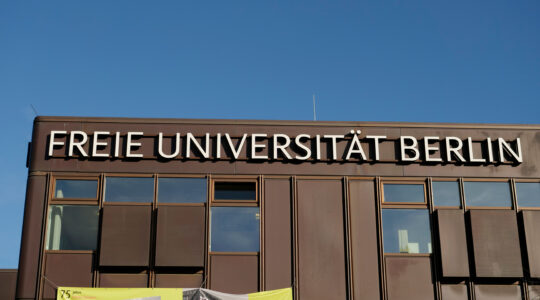PRAGUE (JTA) – An unusual twist in one of the largest restitution claims for Nazi-era art may complicate the recovery efforts by the heirs of a Dutch Jewish art dealer.
The claim covers some 227artworks, including pieces by the Old Masters, that the four children of Nathan Katz claim he lost to the Nazis during World War II. The Dutch state took possession of the works after the war, installing them in galleries and museums.
The catch, however, is that the Nazis may have obtained the paintings legally.
Unlike in many other restitution cases, an unknown number of the works the Katz heirs are seeking to recover were not confiscated but sold, possibly at market value.
Katz’s daughter, Sybilla Goldstein-Katz, who lives in Florida, said through a lawyer that the works were sold to obtain safe passage from the Nazis. For instance, a Rembrandt secured the release of Katz’s mother from the Westerbork concentration camp, one newspaper reported.
“He had to do business with them; the pistol was to his nose,” one of Katz’s other children, 88-year-old David Katz of Switzerland, said of his father’s dealings with the Nazis.
However, a prominent Dutch looted-art expert, Rudi Ekkart, who helped create the standards used by a committee that advises the Dutch government on art restitution, said some of the paintings listed in the claim were sold before World War II even began.
The trove is particularly valuable, curators say, with prized paintings by the 17th century artists Jan Steen, Gerard Dou and Jacob van Ruisdael.
One leading Dutch newspaper, NRC Handelsblad, reported that Katz sold the paintings voluntarily and at fair price to Alois Miedl, a Katz friend from Germany who became the buyer for Nazi leader Hermann Goering.
The Katz claim is “absolute nonsense,” said Gerart Aalders, a historian at the Institute for War Documentation in Amsterdam who has written three books on the Nazi pillaging of Jewish property in Holland. “The archives clearly show that Katz willingly sold works to a friend under no duress. He also continued to sell to the Germans even after he had escaped to Switzerland.”
Tina Talarchyk, the Katz heirs’ lawyer in Florida, told JTA in an e-mail that Katz bartered and sold his art to save himself and dozens of family members from the Nazis, who murdered three-quarters of Holland’s 150,000 Jews during the Holocaust.
“Nathan Katz and his collection of art was a target of Hitler and the Nazis long before the occupation of Holland,” said Talarchyk, from the firm Squire, Sanders & Dempsey. “Hitler’s grand plan for his Linz Museum was almost as famous and as aggressive as his plan to exterminate Jews.“
Conceived of by Hitler, the museum at Linz was to be the Nazis’ Aryan Louvre. During the course of the war Hitler dispatched art specialists and curators to obtain, often by seizure, thousands of artworks from around the world.
The Katz claim was filed in March but revealed only this month when the Dutch government notified the directors of the museums that today house the disputed objects – 225 paintings and two tapestries.
The claim could take years for the Dutch looted-art restitution commission to evaluate.
The case highlights one of the most contentious areas in the quest for Holocaust restitution: how present-day European governments evaluate World War II-era sales by Jewish art dealers in Nazi-occupied lands.
It also is a reminder that there are Jewish heirs only now discovering their family treasures in the halls or basements of Europe’s great museums.
“I think on the art issue there has been the least amount of progress out of all the areas of Holocaust-era restitution,” said Gideon Taylor, executive vice president of the Conference on Jewish Material Claims Against Germany.
In a famous case illustrative of the difficulty in Holland of recovering art sold by compulsion during the Nazi era, a Dutch court in 1998 rejected the efforts by Jewish heirs to recover works that Jewish art dealer Jacques Goudstikker sold during the war to save his family.
Holland subsequently established a restitution committee in 2001 to deal with the claims, and in 2006 more than 200 artworks were returned to the Goudstikker heirs.
As one of the only European nations actively seeking potential claimants, the Netherlands in recent years has become a model for restituting Nazi-looted art, Taylor said. By May 2007, the Dutch government processed some 38 claims, mostly in full or partial favor to the claimants, and more than 420 artworks were returned.
This figure dwarfs the estimated 4,000 pieces in Dutch state collections the restitution committee believes were stolen by the Nazis, mostly from Jews.
Nazis did not begin expropriating Jewish property in Holland until March 1941, when the concentration-camp deportations began.
“The price of art actually went up at this time because everyone knew the Nazis were out to acquire works,” Ekkart said. “There is no question that in those first two years Jewish galleries were buying and selling at market prices.”
The difficulty for the Katz heirs may be in proving the sales were forced.
“You would have to prove the sale was, for example, half of the market value, or that at the moment of the sale the owner was planning an escape, or that there are indications of a connection between a sale and an escape or other efforts to secure safety,” Ekkart explained.
Holland had numerous Jewish art dealers before World War II, many of whom remained in the country after the German invasion of May 1940. From the start of the occupation, German authorities banned Jews from Holland’s civil service and required them to register their business assets.
In January 1941, all Jews were required to register with local authorities. Two months later the liquidation and “Aryanization” of Jewish businesses began.
“There was nothing voluntary about any aspect of any sale or transaction in the 1940s,” Katz lawyer Talarchyk said.
“It was a terrible atmosphere for Jews from the start, and it only got worse,” said David Katz, who was a soldier in Rotterdam when the Germans bombed the city in 1940. Katz told JTA that Nazi pressure on his father began immediately after the invasion.
Once the deportations began Katz, his wife and four children went into hiding. In the end, the intervention of a contact in Switzerland helped the family secure their exit to safety. The elder Katz died in Switzerland after the war.
The Katz children, three of whom live in Europe, submitted a claim for one piece of artwork in 2003 as a test case, then filed their massive claim in March to meet a government deadline that has since been extended.
Evelien Campfens, the rapporteur for Holland’s restitution committee, said the committee spends an average of 10 months on each case. As for the veracity of the Katz claim, Campfens refused to speculate.
“We do not discuss claims that are under review,” she said.
JTA has documented Jewish history in real-time for over a century. Keep our journalism strong by joining us in supporting independent, award-winning reporting.





